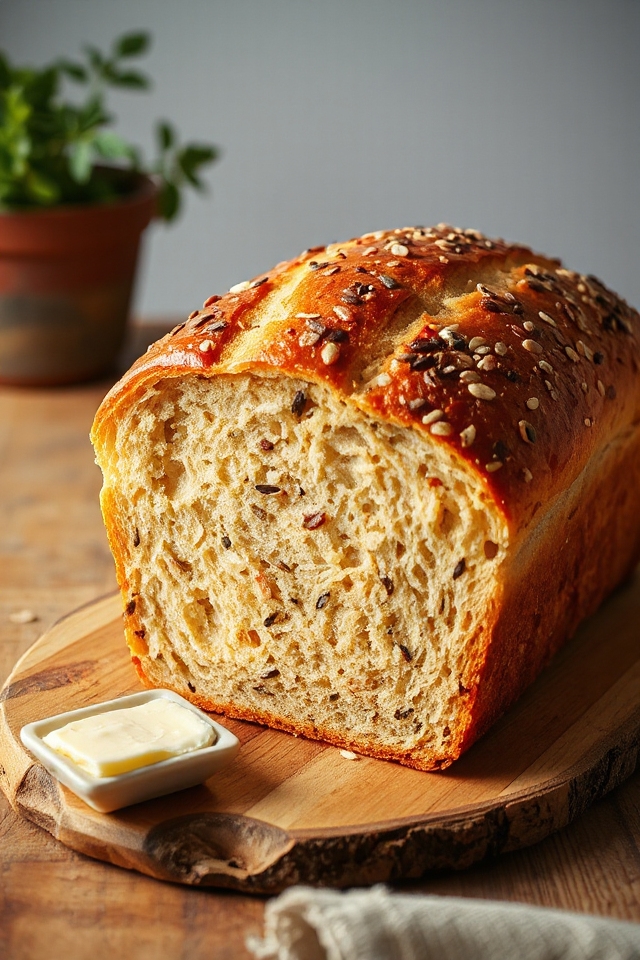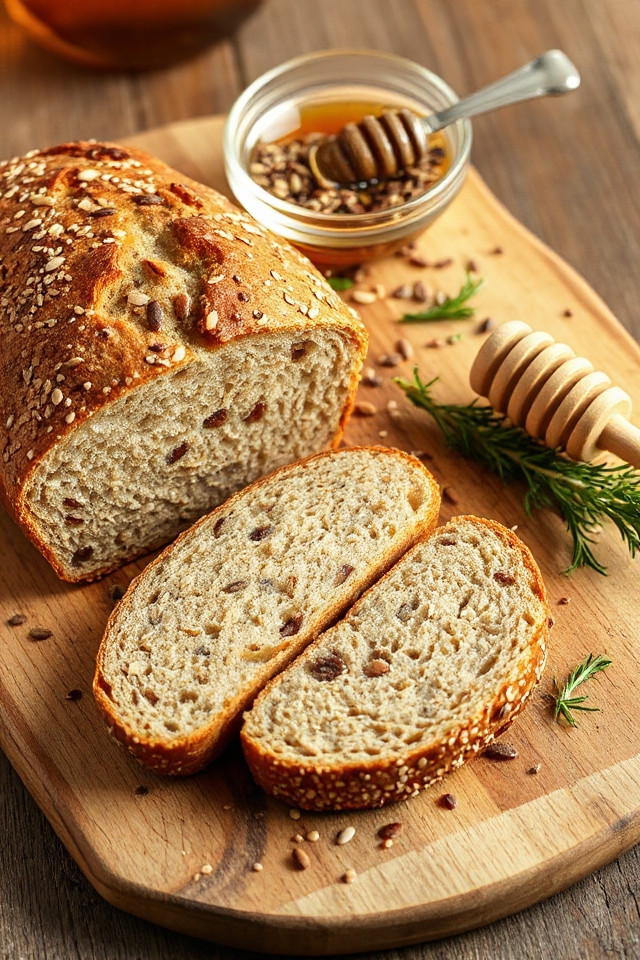Why You’ll Love This Seed Bread Recipe
If you’re like me and love the nutty flavor and hearty texture of whole grain breads, you’ll definitely appreciate this Seed Bread recipe.
It’s not just delicious; it’s packed with nutrients from various seeds that add a delightful crunch.
I love how the aroma fills my kitchen while it bakes, creating an inviting atmosphere.
Plus, this bread is incredibly versatile—perfect for sandwiches, toast, or just with a bit of butter.
The satisfaction of baking my own bread is unmatched, and sharing it with friends and family makes it even better.
Trust me; you’ll want to make this again and again!
Ingredients of Seed Bread
When it comes to making Seed Bread, the ingredients aren’t just a list; they’re the heart and soul of the recipe. Each component plays a role in creating that delightful, nutty flavor and satisfying texture.
Plus, think of all the wonderful nutrients you’re packing into each slice. If you’re ready to embark on this baking adventure, let’s check out what you’ll need to gather from your pantry.
Ingredients:
- 2 1/4 teaspoons of yeast
- 2 1/4 cups of warm water
- 4 cups of all-purpose flour
- 2 cups of whole wheat flour
- 1/2 cup of flax seeds
- 4 tablespoons of sesame seeds
- 2 tablespoons of poppy seeds
- 1/4 cup of flax seed meal
- 1 teaspoon of salt
- 4 tablespoons of honey
- 1/3 cup of vegetable oil or olive oil
- 1 teaspoon of sesame oil
Now, let’s chat a bit about these ingredients. If you’re like me, you might’ve a love-hate relationship with yeast. It can be a little finicky, but it’s what gives your bread that amazing rise and fluffy texture.
And don’t even get me started on the seeds. They add such a nice crunch and a pop of flavor. You can also mix and match the types of seeds based on your preferences. If you’re not a fan of poppy seeds, swap them out for something else—sunflower seeds, perhaps?
Don’t be afraid to get creative! Just remember, the fresher your ingredients, the better your bread will taste. Happy baking!
How to Make Seed Bread

Making Seed Bread is like starting a cozy baking adventure—one that’s full of delightful aromas and the promise of delicious, fresh bread. So, let’s roll up our sleeves and plunge into the process.
Start by dissolving 2 1/4 teaspoons of yeast in 1/4 cup of warm water. This part is essential; give it about 5 to 10 minutes to get all frothy and excited. If you’re feeling generous, a pinch of sugar can give the yeast a little boost.
Meanwhile, in a separate bowl, combine 4 cups of all-purpose flour, 2 cups of whole wheat flour, 1/2 cup of flax seeds, 4 tablespoons of sesame seeds, 2 tablespoons of poppy seeds, 1/4 cup of flax seed meal, and 1 teaspoon of salt. This mixture is going to become the backbone of your bread, so mix it well!
Now, in a large bowl, pour in the remaining 2 cups of warm water, along with 4 tablespoons of honey and 1/3 cup of your favorite oil—be it vegetable or olive. Once that’s all mixed together, add in the frothy yeast concoction, followed by about 2 cups of your flour and seed mix. Stir it up until you have a ragged dough.
At this point, you can start kneading the dough. If kneading feels like a workout, you’re not alone—I often feel like a baker’s version of a gym rat. Gradually add the remaining flour mixture, about 1 to 1 1/2 cups at a time, kneading until everything is well combined and the dough is smooth.
Place that lovely dough in an oiled bowl and cover it with some wax paper sprayed with oil and a damp tea towel. Now, find a warm spot for it to rise for about 1 to 1 1/2 hours until it doubles in size.
Once your dough has risen, it’s time for some fun! Punch it down—yes, punch it, but gently, of course—and divide it into two equal portions. Shape each piece into a bun and place them in oiled bread pans. Cover them again and let them rise for an additional 20 minutes.
Preheat your oven to 450 degrees. When you’re ready, pop those loaves in the oven. After 10 minutes, reduce the temperature to 350 degrees and let them bake for another 30 minutes. The smell will be incredible, and you may find it hard to wait.
When they’re done, let them cool on a rack before indulging. Trust me, the satisfaction of slicing into a freshly baked loaf is worth every moment spent in the kitchen. Enjoy your Seed Bread—it’s a labor of love that you can feel good about sharing!
Seed Bread Substitutions & Variations
Exploring substitutions and variations for seed bread can elevate your baking experience and cater to your taste preferences.
For instance, if you’re out of whole wheat flour, try using spelt or rye flour instead. I love swapping in different seeds like chia or pumpkin seeds for a unique flavor.
You can also play with oils; using coconut oil adds a delightful twist. If you prefer a sweeter bread, consider adding dried fruits like raisins or cranberries.
For a savory touch, try incorporating herbs like rosemary or thyme. The possibilities are endless, so get creative and enjoy your baking journey!
Additional Tips & Notes
Experimenting with different ingredients can be fun, but there are also some helpful tips to keep in mind for the best results with seed bread.
First, make sure your yeast is fresh; it’s vital for a good rise. I find that kneading the dough for at least 10 minutes helps develop the gluten, giving the bread a better texture.
Also, using a warm, draft-free area for rising is essential. If you want a crustier loaf, try placing a pan of water in the oven while baking.
Finally, let the bread cool completely before slicing to avoid a gummy texture. Enjoy!
